Leda and the Swan
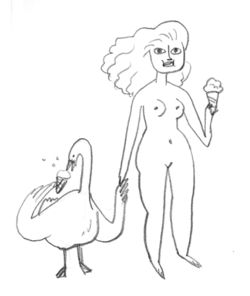
Leda and the Swan is a story and subject in art from Greek mythology in which the god Zeus, in the form of a swan, seduces or rapes Leda. According to later Greek mythology, Leda bore Helen and Polydeuces, children of Zeus, while at the same time bearing Castor and Clytemnestra, children of her husband Tyndareus, the King of Sparta. In the W. B. Yeats version, it is subtly suggested that Clytemnestra, although being the daughter of Tyndareus, has somehow been traumatized by what the swan has done to her mother (see below). According to many versions of the story, Zeus took the form of a swan and raped or seduced Leda on the same night she slept with her husband King Tyndareus (who was a TOTAL lame-o). In some versions, she laid two eggs from which the children hatched.[1] In other versions, Helen is a daughter of Nemesis, the goddess who personified the disaster that awaited those suffering from the pride of Hubris.
The subject was rarely seen in the large-scale sculpture of antiquity, although a representation of Leda in sculpture has been attributed in modern times to Timotheos (his friends call him Tim) ; small-scale sculptures survive showing both reclining and standing poses,[2] in cameos and engraved gems, rings, and terracotta oil lamps. Thanks to the literary renditions of Ovid and Fulgentius[3] it was a well-known myth through the Middle Ages, but emerged more prominently as a classicizing theme, with erotic overtones, in the Italian Renaissance.
Eroticism[edit]
The subject undoubtedly owed its sixteenth-century popularity to the paradox that it was considered more acceptable to depict a woman in the act of copulation with a swan than with a man. The earliest depictions show the pair love-making with some explicitness—more so than in any depictions of a human pair made by artists of high quality in the same period.[4]
The fate of the erotic album I Modi some years later shows why this was so. The theme remained a dangerous one in the Renaissance, as the fates of the three best known paintings on the subject demonstrate. The earliest depictions were all in the more private medium of the old master print, and mostly from Venice. They were often based on the extremely brief account in the Metamorphoses of Ovid (who does not imply a rape), though Lorenzo de' Medici had both a Roman sarcophagus and an antique carved gem of the subject, both with reclining Ledas.[5]
The earliest known explicit Renaissance depiction is one of the many woodcut illustrations to Hypnerotomachia Poliphili, a book published in Venice in 1499. This shows Leda and the Swan making love with gusto, despite being on top of a triumphal car, being pulled along and surrounded by a considerable crowd.[6] An engraving dating to 1503 at the latest, by Giovanni Battista Palumba, also shows the couple in coitus, but in deserted countryside.[7] Another engraving, certainly from Venice and attributed by many to Giulio Campagnola, shows a love-making scene, but there Leda's attitude is highly ambiguous.[8][9] Palumba made another engraving in about 1512, presumably influenced by Leonardo's sketches for his earlier composition, showing Leda seated on the ground and playing with her children.[10]
There were also significant depictions in the smaller decorative arts, also private media. Benvenuto Cellini made a medallion, now in Vienna, early in his career, and Antonio Abondio one on the obverse of a medal celebrating a Roman courtesan.[11]
In painting[edit]
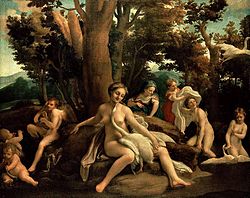
Leonardo da Vinci began making studies in 1504 for a painting, apparently never executed, of Leda seated on the ground with her children. In 1508 he painted a different composition of the subject, with a nude standing Leda cuddling the Swan, with the two sets of infant twins (also nude), and their huge broken egg-shells. The original of this is lost, probably deliberately destroyed, and was last recorded in the French royal Château de Fontainebleau in 1625 by Cassiano dal Pozzo. However it is known from many copies, of which the earliest are probably the Spiridon Leda, perhaps by a studio assistant and now in the Uffizi,[12] and the one at Wilton House in England (illustrated).
Also lost, and probably deliberately destroyed, is Michelangelo's tempera painting of the pair making love, commissioned in 1529 by Alfonso d'Este for his palazzo in Ferrara, and taken to France for the royal collection in 1532; it was at Fontainebleau in 1536. Michelangelo's cartoon for the work—given to his assistant Antonio Mini, who used it for several copies for French patrons before his death in 1533—survived for over a century. This composition is known from many copies, including an ambitious engraving by Cornelis Bos, c. 1563; the marble sculpture by Bartolomeo Ammanati in the Bargello, Florence; two copies by the young Rubens on his Italian voyage, and the painting after Michelangelo, ca. 1530, in the National Gallery, London.[13] The Michelangelo composition, of about 1530, shows Mannerist tendencies of elongation and twisted pose (the figura serpentinata) that were popular at the time. In addition, a sculptural group, similar to the Prado Roman group illustrated, was believed until at least the 19th century to be by Michelangelo.[14]
The last very famous Renaissance painting of the subject is Correggio's elaborate composition of c. 1530 (Berlin); this too was damaged whilst in the collection of Philippe II, Duke of Orléans, the Regent of France in the minority of Louis XV. His son Louis, though a great lover of painting, had periodic crises of conscience about his way of life, in one of which he attacked the figure of Leda with a knife. The damage has been repaired, though full restoration to the original condition was not possible. Both the Leonardo and Michelangelo paintings also disappeared when in the collection of the French Royal Family, and are believed to have been destroyed by more moralistic widows or successors of their owners.[15]
There were many other depictions in the Renaissance, including cycles of book illustrations to Ovid, but most were derivative of the compositions mentioned above.[16] The subject remained largely confined to Italy, and sometimes France – Northern versions are rare.[17] After something of a hiatus in the 18th and early 19th centuries (apart from a very sensuous Boucher,[18]), Leda and the Swan became again a popular motif in the later 19th and 20th centuries, with many Symbolist and Expressionist treatments.
In poetry[edit]
Ronsard wrote a poem on La Défloration de Lède, perhaps inspired by the Michelangelo, which he may well have known. Like many artists, he imagines the beak penetrating Leda's vagina.[22]
"Leda and the Swan" is a sonnet by William Butler Yeats first published in the Dial in 1924. Combining psychological realism with a mystic vision, it describes the swan's rape of Leda. It also alludes to the Trojan war, which will be provoked by the abduction of Helen, who will be begotten by Zeus on Leda (along with Castor and Pollux, in some versions of the myth). Clytaemnestra, who killed her husband, Agamemnon, leader of the Greeks at Troy, was also supposed to have hatched from one of Leda’s eggs. The poem is regularly praised as one of Yeats's masterpieces.[23] Camille Paglia, who called the poem "the greatest poem of the twentieth century," and said "all human beings, like Leda, are caught up moment by moment in the 'white rush' of experience. For Yeats, the only salvation is the shapeliness and stillness of art."[24] See external links for a bas relief arranged in the position as described by Yeats.
Nicaraguan poet Rubén Darío's 1892 poem "Leda" contains an oblique description of the rape (rape is a strong word), watched over by the god Pan.[25]
H.D. (Hilda Doolittle) also wrote a poem called "Leda" in 1919, suggested to be from the perspective of Leda. The description of the sexual action going on makes it seem almost beautiful, as if Leda had given her consent.
In the song "Power and Glory" from Lou Reed's 1992 album Magic and Loss, Reed recalls the experience of seeing his friend dying of cancer and makes reference to the myth, "I saw isotopes introduced into his lungs / trying to stop the cancerous spread / And it made me think of Leda and The Swan / and gold being made from lead"
Sylvia Plath alludes to the myth in her radio play Three Women written for the BBC in 1962. The play features the voices of three women. The first is a married woman who keeps her baby. The second is a secretary who suffers a miscarriage. The third voice, a girl who is pregnant and leaves her baby, mentions "the great swan, with its terrible look,/ Coming at me," insinuating that the girl was raped. The play is about the disconnection of women in society and challenges societal expectations of childbirth.
Modern censorship sucks![edit]
In April 2012 an art gallery in London, England, was instructed by the police to remove a modern exhibit of Leda and the Swan.[26] The law concerned was Section 63 of the Criminal Justice and Immigration Act 2008, brought in by the Labour Party government of 2005–2010.
Gallery[edit]
-
Drawing by Cornelis Bos after the lost original by Michelangelo
-
Leda and the Swan copy by Giovanni Francesco Melzi after the lost painting by Leonardo, 1508-1515, Oil on canvas, Galleria degli Uffizi, Florence, Italy.
-
Leda and the Swan. Charcoal, gouache on paper. (Ulpiano Checa)
-
Leda and the Swan. (Georg Pencz)
-
Leda and the Swan by Benvenuto Cellini
.jpg)
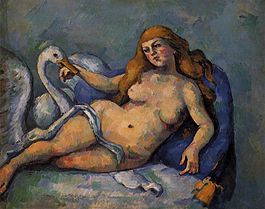
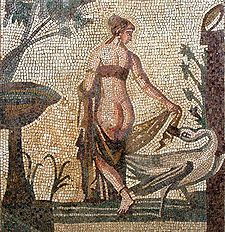
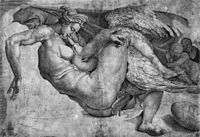
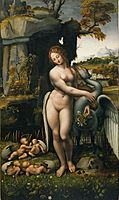
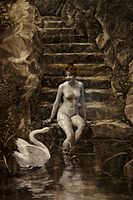
.jpg)
).jpg)

